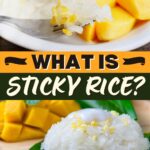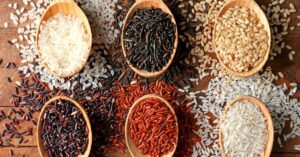It’s time to get to the bottom of one of the most pressing questions in the culinary world: what is sticky rice?
Sticky rice has a texture like no other. When cooked, the grains stick together, creating a soft and chewy texture that’s irresistible.

It’s perfect for both sweet and savory dishes, from sushi to rice cakes, and even desserts like mango sticky rice.
What Is Sticky Rice?
Sticky rice is also called glutinous rice or sweet rice, but don’t be fooled by the name. It doesn’t contain any gluten.
Instead, the name “glutinous” refers to the sticky, glue-like texture it has when cooked.
This is because of its higher amylopectin content and almost no amylose, the two types of starch found in rice grains.
There are different types of sticky rice, from long-grain to short-grain and white to purple.
But one thing they all have in common is that they’re high in dextrin and maltose.
When cooked, grains of sticky rice stick together in a single mass.
This makes it easy to pick up with chopsticks or form into different shapes.
This makes it perfect for dishes like sushi, rice cakes, and desserts. And it’s not just limited to Asian recipes.
Sticky rice is used in all kinds of dishes around the world.
What Does Sticky Rice Taste Like?
Sticky rice is soft, chewy, and slightly sweet, with a unique flavor that sets it apart from regular rice.
Some people describe it as nutty, while others say it has a subtle floral or coconut flavor.
Ultimately, the answer depends on a few different factors. First, the level of refinement plays a big role.
If you opt for whole-grain sticky rice (brown rice), you’ll get a nuttier, more wholesome flavor.
If you go for polished sticky rice (white rice), you’ll get a more subtle flavor.
So, what’s the secret behind sticky rice’s amazing taste? Well, it’s all in the starch.
When cooked, the rice grains stick together in a single mass, creating a rich and velvety texture that’s irresistible.

Types of Sticky Rice
Any type of rice that has a high amylopectin content and low amylose content can be considered sticky.
Here are some of the most common types of sticky rice that you’ll see out there:
Black and purple sticky rice: These Southeast Asian whole-grain rice varieties have a distinctive dark purple or black bran when raw.
When cooked, the bran dyes the white inner endosperm a beautiful deep purple color.
Japanese sweet rice: This short-grain variety of Japanese rice is known for its opaque grains, sweet flavor, and incredibly sticky texture.
It’s primarily used for making desserts like mochi and other sweet treats.
Thai sticky rice: This variety of sticky rice is popular in Laos and Northern Thailand and has a longer grain than Japanese sticky rice.
It also has a more floral scent, making it perfect for savory dishes like coconut sticky rice.
Sticky Rice vs. Other White Rice
Unlike other types of rice that contain both amylose and amylopectin starch, sticky rice is unique.
It has an incredibly low amylose content and a high concentration of amylopectin.
This gives it its trademark sticky texture when cooked.
Other types of rice like long-grain white rice have a higher amylose content and turn out fluffy when cooked.
Short-grain white rice, however, has a lower amylose content causing the grains to stick together.
But with sticky rice, it’s all about that amylopectin.
This special type of rice creates a velvety texture that’s perfect for both sweet and savory dishes.

Sticky Rice Uses
Here are 10 different ways you can use sticky rice:
- Sushi: Sticky rice is the perfect base for sushi rolls, as it’s sticky enough to hold everything together.
- Rice balls: These are a popular snack in Japan, made by forming sticky rice into balls and adding savory or sweet fillings.
- Rice cakes: Sticky rice is a key ingredient in many traditional rice cakes, which are often steamed or fried.
- Rice pudding: Creamy and comforting, rice pudding is a popular dessert made with sticky rice.
- Mango sticky rice: This Thai dessert combines sticky rice with fresh mango and coconut milk for a tropical treat.
- Zongzi: These Chinese sticky rice dumplings are often filled with pork, mushrooms, and peanuts.
- Bibimbap: This Korean dish features a bowl of sticky rice topped with various vegetables, meat, and a fried egg.
- Onigiri: Another Japanese snack, onigiri are triangular rice balls filled with various ingredients and often wrapped in seaweed.
- Coconut sticky rice: This Thai dish is a perfect accompaniment to grilled meats or curries.
- Stir-fry: Sticky rice can be used as a base for a flavorful stir-fry, absorbing all the delicious sauce and flavor.
How To Make Sticky Rice
While it may seem intimidating, making sticky rice is actually quite simple.
All you need is a steamer and some glutinous or sweet rice.
- First, rinse 1 cup of rice until the water runs clear, then soak it in two inches of cold water for 2 to 24 hours.
- Drain the rice and place it in a fine-mesh strainer or a cheesecloth-lined colander over a saucepan of simmering water. Be sure the strainer doesn’t touch the water.
- Cover and let the rice cook for 15 minutes, then use a large spoon to flip the rice over or stir it so that the bottom layer is on top.
- Cook it for an additional 15 to 20 minutes, until the rice is tender and glossy.

Where to Buy Sticky Rice
You can find sticky rice in most grocery stores and Asian markets in the international or rice section.
You might see it labeled as glutinous rice, pearl rice, mochi rice, and waxy rice.
There are even unmilled black or purple varieties of sticky rice.
How to Store Sticky Rice
To store uncooked sticky rice, make sure it’s sealed and dry in the pantry, refrigerator, or freezer.
Proper storage of cooked sticky rice is crucial to avoid harmful bacteria growth.
To keep your cooked rice safe, cool it quickly by spreading it in a single layer on a baking sheet.
Then, transfer it to an air-tight container and store it in the fridge for up to 4 days or in the freezer for up to a month.










